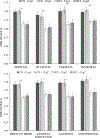Brain function complexity during dual-tasking is associated with cognitive impairment and age
- PMID: 35843726
- PMCID: PMC9649845
- DOI: 10.1111/jon.13025
Brain function complexity during dual-tasking is associated with cognitive impairment and age
Abstract
Background and purpose: Early diagnosis of cognitive impairment is important because symptoms can be delayed through therapies. Synaptic disconnections are the key characteristics of dementia, and through nonlinear complexity analysis of brain function, it is possible to identify long-range synaptic disconnections in the brain.
Methods: We investigated the capability of a novel upper-extremity function (UEF) dual-task paradigm in the functional MRI (fMRI) setting, where the participant flexes and extends their arm while counting, to differentiate between cognitively normal (CN) and those with mild cognitive impairment (MCI). We used multiscale entropy (MSE) complexity analysis of the blood oxygen-level dependent time-series across neural networks and brain regions. Outside of the fMRI, we used the UEF dual-task test, while the elbow kinematics were measured using motion sensors, to record the motor function score.
Results: Results showed 34% lower MSE values in MCI compared to CN (p<.04 for all regions and networks except cerebellum when counting down by one; effect size = 1.35±0.15) and a negative correlation between MSE values and age (average r2 of 0.30 for counting down by one and 0.36 for counting backward by three). Results also showed an improvement in the logistic regression model sensitivity by 14-24% in predicting the presence of MCI when brain function measure was added to the motor function score (kinematics data).
Conclusions: Current findings suggest that combining measures of neural network and motor function, in addition to neuropsychological testing, may provide an accurate tool for assessing early-stage cognitive impairment and age-related decline in cognition.
Keywords: Alzheimer's disease; aging; dual-task function; entropy; fMRI; repeatability.
© 2022 American Society of Neuroimaging.
Figures




References
-
- Takizawa C, Thompson PL, van Walsem A, Faure C, Maier WC. Epidemiological and economic burden of Alzheimer’s disease: A systematic literature review of data across europe and the United States of America. J Alzheimers Dis 2014;43:1271–84. - PubMed
-
- Camicioli R, Howieson D, Lehman S, Kaye J. Talking while walking: The effect of a dual task in aging and Alzheimer’s disease. Neurology 1997;48:955–8. - PubMed
-
- Montero-Odasso M, Muir SW, Speechley M. Dual-task complexity affects gait in people with mild cognitive impairment: The interplay between gait variability, dual tasking, and risk of falls. Arch Phys Med Rehabil 2012;93:293–9. - PubMed
Publication types
MeSH terms
Grants and funding
LinkOut - more resources
Full Text Sources

